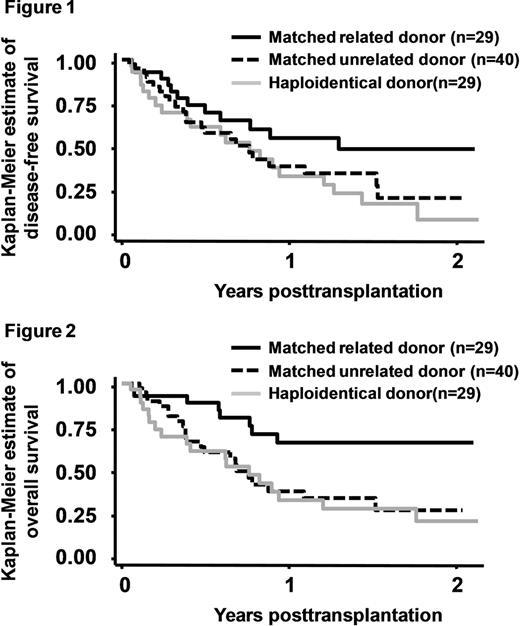Abstract
Abstract 3541
We have previously shown that SCT from HLA-haploidentical related donors (HAPLO) after nonmyeloablative conditioning is feasible with a low incidence of grade III-IV acute GVHD or treatment-related mortality (TRM) (Rizzieri et al. JCO 2007). We now report our comparative study in patients who received SCT from a 6/6 HLA-matched related (MRD), 8–10/8 HLA-matched unrelated (MUD), or HAPLO donor, after nonmyeloablative conditioning.
Patients with chemosensitive relapse or high risk disease with minimal residual disease at study entry were eligible. The conditioning regimen consisted of fludarabine, 40 mg/m2 for 4 days; melphalan, 140 mg/m2 for 1 day; and alemtuzumab, 20 mg for 4 days for patients with lymphoid or myelomatous diseases. Fludarabine and alemtuzumab at the same doses with busulfan, 130 mg/m2 for 2 days was used for patients with myeloid diseases. Mycophenolate mofetil was used for GVHD prophylaxis. Donor lymphocyte infusions were performed in 15 MRD patients and 4 HAPLO patients. Disease-free survival (DFS) and overall survival (OS) rates after SCT were estimated using the Kaplan–Meier method, and univariate comparisons were performed using the log-rank test. Cox proportional-hazards regression was used to evaluate variables that potentially affected the survival rates.
The lymphoid cohort included 52 patients with ALL (n = 6), lymphoma (n = 42), or myeloma (n = 4), whereas the myeloid cohort included 46 patients with AML/MDS (n = 40), and myeloproliferative disorder (MPD) (n = 6). The median subject age was 56.5 (range, 20–73) years with a median follow-up of 15 months among survivors. A total of 29, 40, and 29 patients received transplants from MRD, MUD, and HAPLO, respectively. All 29 patients engrafted after HCT from MRD. One of 40 patients who received SCT from MUD had a primary graft failure (GF), with 2 secondary GF and 1 early relapse. Two of them were rescued by subsequent nonmyeloablative SCT from the same MUD or new HAPLO donor. Among 28 HAPLO patients evaluable for engraftment, 8 had a primary GF, 6 of these had myeloid disease; 2 additional patients had donor cell recovery but without full recovery of normal blood counts. Three of the 8 were rescued with subsequent nonmyeloablative SCT from the same donor. The transplant regimen resulted in 11% TRM at day 100. Grade III-IV acute GVHD rates were 0/29 (0%), 4/40 (10%), and 5/29 (17%) in patients who received a transplant from a MRD, MUD, or HAPLO, respectively. CMV reactivation occurred in 57% of patients and 6% developed CMV disease. Other infectious complications included polyomavirus in 24% of patients, bacteria in 23%, respiratory viruses in 13%, and fungal infections in 7%. The common causes of death were progressive disease (30% for all cause of death) and infections (32%). The 1-year DFS rate after SCT from MRD, MUD, and HAPLO was 55% (95% CI, 33–73%), 39% (22–56%), and 34% (16–53%), respectively (Log-rank test, P = 0.094) (Figure 1); the corresponding 1-year OS rate was 66% (43–82%), 39% (21–55%), and 34% (16–53%), respectively (Log-rank test, P = 0.012) (Figure 2). Multivariate analysis revealed that SCT from MUD/HAPLO, compared with that from MRD, was the only adverse factor that affected the OS rate (HR for MUD, 2.62 (95% CI, 1.15–5.96), P = 0.022; HR for HAPLO, 3.17 (1.36–7.37), P = 0.007), but the OS rate after SCT from HAPLO did not significantly differ from that after SCT from MUD (P = 0.560). Other variables (recipient age, conditioning regimen, and disease status at transplant) were not significantly associated with the outcome.
The results show the feasibility of this approach with this regimen and the clinical outcomes in patients who received transplants from HAPLO are comparable to patients who received transplants from MUD. Development of strategies to improve immune recovery remains a current challenge.
Off Label Use: Alemtuzumab for conditioning in allogeneic stem cell transplantation. Horwitz:Genzyme: Honoraria, Research Funding. Chao:Genzyme: Research Funding. Rizzieri:Genzyme: Speakers Bureau.
Author notes
Asterisk with author names denotes non-ASH members.


This feature is available to Subscribers Only
Sign In or Create an Account Close Modal